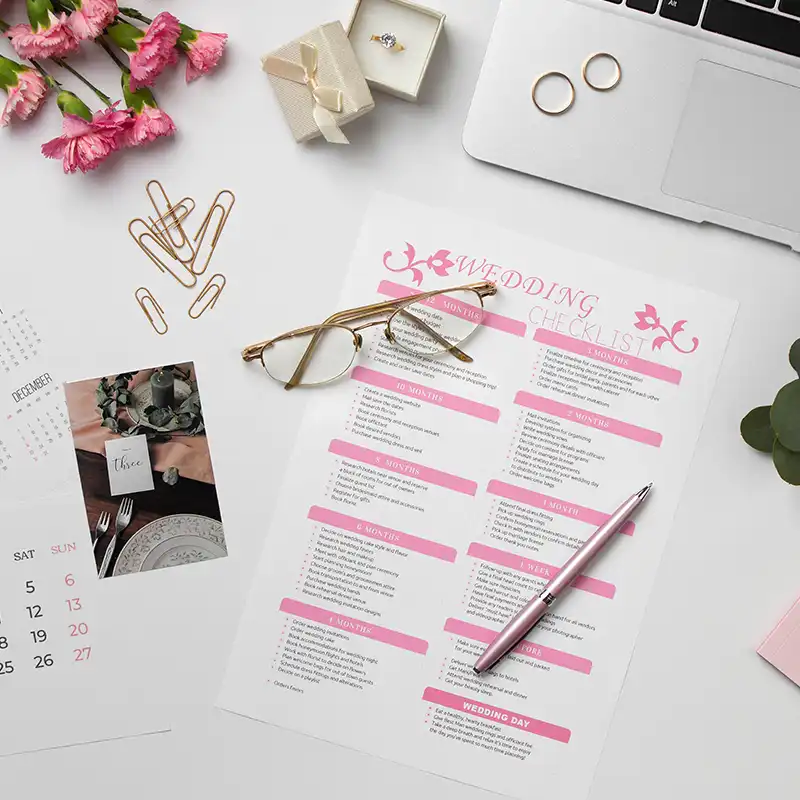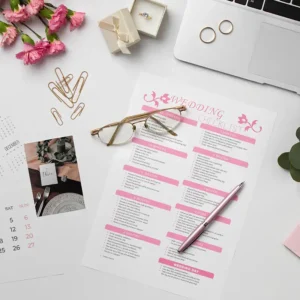Tracking who’s coming to your wedding shouldn’t feel like detective work – but for many couples, it quickly turns into late-night calls, last-minute guesswork, and a whole lot of stress. Missing RSVPs mean caterers can’t get final numbers, seating charts stay unfinished, and suddenly you’re worried about running out of food or chairs.
But first, what does RSVP even mean?
RSVP comes from the French phrase “Répondez s’il vous plaît” which simply means “Please respond.” It’s your way of politely asking guests to confirm whether they will attend your wedding or not, so you can plan seating, food, and logistics without guessing.
The good news? Managing RSVPs in 2025 doesn’t have to be a headache. With the right mix of clear communication, smart deadlines, and simple digital tools, you can get accurate headcounts without chasing every relative on WhatsApp.
That’s where The Wedding Ties comes in. After planning weddings across India – from grand Rajasthan palaces to intimate Goan beaches – we’ve seen exactly what works (and what causes chaos). Our goal is simple: keep you focused on the moments that matter while we take care of the guest list drama.
This guide walks you through easy, modern ways to handle RSVPs from choosing paper or digital invites to tracking meal choices and gently following up with guests who forget to reply. By the end, you’ll have a clear plan that saves time, avoids stress, and ensures every seat is filled with the people you love.
Choose the Right RSVP Method
Digital vs. Traditional – What Works Best Today?
The way you ask guests to RSVP can make your planning feel effortless or chaotic. Your choice should match your wedding style, budget and how tech-savvy your guests are.
Let’s break it down simply:
Traditional (Paper Cards)
Pros:
- Adds a formal, elegant touch – perfect for black-tie or very traditional weddings.
- Tangible keepsake for couples and guests.
- Works for everyone, including relatives who aren’t comfortable with technology.
Cons:
- Costs more (printing + stamps) and takes longer because you rely on postal delays.
- You have to manually collect and enter every response.
- Cards can get lost or arrive late, causing last-minute stress.
Digital RSVPs (Websites/Apps)
Pros:
- Quick and cost-effective – most tools are free or very affordable.
- Real-time tracking with automated reminders (no chasing guests manually).
- Eco-friendly and easy to collect extras like meal choices, song requests, or plus-one names.
Cons:
- Might feel less “formal” to very traditional families.
- Some older guests might find it tricky or may ignore emails/links if not reminded.
Hybrid Approach (Our Favourite!)
How it Works:
Send beautiful printed invitations, but replace the return card with a QR code or website link. Guests simply scan and RSVP online – giving you speed, tracking and a formal feel all in one.
Why It’s Smart:
- Perfect balance for Indian weddings where guest lists are diverse (tech-savvy cousins + old-school relatives).
- Saves money on return postage while keeping the elegance of a physical invite.
- Ensures faster responses without compromising tradition.
Set Clear Deadlines That Guests Actually Follow
One of the biggest RSVP headaches is guests who respond at the last minute (or not at all!). The secret is not just picking a date but setting it strategically and reminding people gently, so you have time to finalize your seating, catering and décor without panic.
The Ideal Timeline
- Send Invitations: 6–8 weeks before the wedding (10–12 weeks for destination weddings).
- Set RSVP Deadline: 3–4 weeks before the wedding. This gives you a buffer of about 10–14 days to follow up with guests before vendors need the final headcount.
- Vendor Final Count:Most caterers and venues need confirmed numbers 1–2 weeks in advance, so be sure to build this into your plan.
Example:
For a wedding on 21 November 2025, send invitations by early October, set the RSVP deadline for around 31 October, spend the first week of November following up with any stragglers, and give your final count to vendors 1–2 weeks before the wedding.
Make the Date Impossible to Miss
- Highlight it clearly: Use bold text like “Kindly RSVP by 31 October” on your cards and wedding website .
- Repeat on all channels: Mention the date on printed invites, WhatsApp reminders and wedding website/app notifications.
- Keep wording friendly: Instead of sounding strict, try: “We can’t wait to celebrate , let us know by 31 October so we can save you a seat!”
What If Guests Miss the Deadline?
It happens – even with reminders, 10–20% of guests will forget. Here’s how to handle it without stress:
- Send Gentle Nudges: Text or call them personally within a week of the deadline. Example:
“Hi [Name], just checking if we can count you in for 21 November. Our caterer needs the final count soon!” - Avoid Guessing: Never assume a “yes” – it risks overspending. If they still don’t reply, politely treat it as a “no” and keep a couple of extra seats as a buffer.
- Stay Flexible: If someone replies late with a valid reason (travel delays, illness), try to accommodate if vendors allow small last-minute changes.
Follow Up Without Feeling Pushy
Chasing RSVPs can feel awkward – no one wants to come across as nagging. But without those last few confirmations, you risk over-ordering food, scrambling on the seating chart, or paying extra for unused plates. The trick is to follow up with kindness, patience and just enough urgency so guests know their response matters.
Timing Is Everything
- Wait Until After the Deadline: Don’t rush. Give guests the full chance to respond on time.
- Start 1–3 Days After Deadline: This is your grace period. Begin follow-ups once cards should have arrived or links should have been seen.
- Wrap It Up Early: Aim to finish follow-ups at least 1 week before your vendor’s final headcount deadline so you still have breathing space.
Choose the Right Channel
Pick what feels natural and respectful based on the guest:
- WhatsApp/Text: Best for quick check-ins – most Indians reply faster here than on email.
- Email: Great for distant relatives or professional contacts; always include the RSVP link for easy access.
- Call: Reserve for close family or elderly relatives who may have missed the invite or aren’t online.
- Group Chat Message: Use only for general reminders, not to call out specific people (avoid embarrassment).
Sample Gentle Follow-Up Messages
1–3 Days After Deadline (Mass Message):
“Hi everyone! Our RSVP deadline just passed and if you’ve already replied – thank you! If not, we’d love to hear from you by Friday so we can finalize the seating chart and catering. Can’t wait to celebrate with you!”
5–7 Days After Deadline (Personal Message):
“Hi [Guest Name], hope you’re doing well! Our caterer needs final numbers soon and we haven’t seen your RSVP yet. Could you confirm if you’ll be joining us by [wedding date] ? We’d really love to have you there.”
Final Tips for Stress-Free RSVP Management
By now, you’ve seen that RSVP management is less about chasing guests and more about setting yourself up for success from the start. Here are a few last tips to keep things running smoothly and keep you sane in the process:
1. Test Everything Before You Send
Before hitting “print” or sharing the RSVP link, double-check the details:
- Scan the QR code on your invite to make sure it works on both desktop and mobile.
- Proofread the RSVP deadline (make sure it’s clear and stands out).
- Verify return addresses on mail-in cards if you’re using them. Catching mistakes now saves weeks of back-and-forth later.
2. Stick to One Master List
Whether it’s a spreadsheet, wedding website, or RSVP app – keep all guest data in one place.
- Update physical responses the day they arrive.
- Use simple color codes (green = yes, red = no) to see your progress at a glance.
- Export this master list when sharing numbers with caterers or decorators – it keeps everyone on the same page.
3. Be Patient but Persistent
Late RSVPs are a reality – usually 10–15% of guests miss the first deadline.
- Use your follow-up buffer wisely and send polite nudges (preferably via WhatsApp or text).
- Once your vendor cut-off date arrives, lock the list – last-minute changes can cost extra or create chaos.
4. Plan for a Few Surprises
In Indian weddings, there’s always a cousin who shows up last-minute or an uncle who cancels on the day. Keep a few extra seats and plates as a buffer so you’re not scrambling.
Let The Wedding Ties Handle It for You
At The Wedding Ties, we believe wedding planning shouldn’t leave you chasing RSVPs or worrying about seating charts – it should let you enjoy every moment of your engagement.
Our team takes care of guest communication,RSVP tracking and itinerary planning, seating coordination, and vendor updates so that you don’t have to stress about last-minute surprises. We even help you delight your guests withcustom hampers and gifting solutions to make the experience extra special.
Talk to our wedding experts today to simplify your RSVP process, coordinate logistics, and make sure your wedding runs on schedule.
Email us atconnect@theweddingties.com
Call us at+91 9076001926
Let’s make sure your wedding day feels joyful, stress-free, and exactly the way you imagined it.
Frequently Asked Questions
Yes! WhatsApp is actually one of the fastest ways to collect RSVPs in India. You can send a short message or create a group for updates (just avoid spamming). At The Wedding Ties, we often combine WhatsApp reminders with formal digital RSVPs for better response rates.
Verbal confirmations are common, but always log them in your master list to avoid forgetting. A quick follow-up text saying, “Thanks for confirming — marking you as a yes!” helps keep records accurate.
Focus on non-responders first. Most RSVP tools allow you to filter and send reminders only to those who haven’t replied. This saves time and avoids annoying guests who already responded.
It’s normal for lists to evolve. If you need to invite someone new, send them a digital invite or WhatsApp message with the RSVP link — no need to reprint cards. Just make sure to update your master list immediately.
Absolutely! Digital RSVPs make this super easy. Add optional fields for vegetarian/non-veg choices, allergies, or even a “song you’d like to dance to.” It keeps guests engaged and helps you personalize the event.









